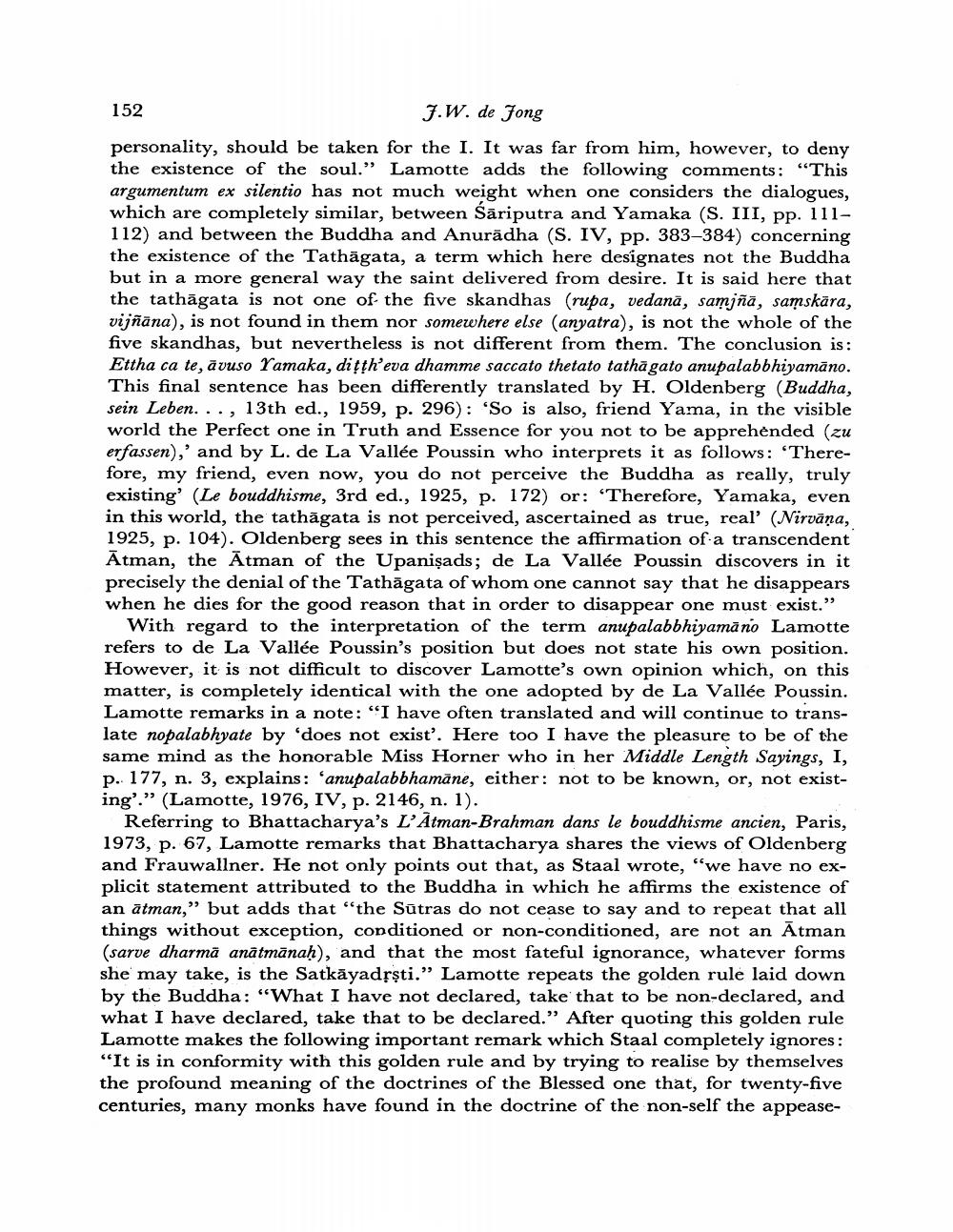Book Title: Lamotte And Doctrine Of Non Self Author(s): J W De Jong Publisher: J W De Jong View full book textPage 2
________________ 152 J.W. de Jong personality, should be taken for the I. It was far from him, however, to deny the existence of the soul.” Lamotte adds the following comments: "This argumentum ex silentio has not much weight when one considers the dialogues, which are completely similar, between Sāriputra and Yamaka (S. III, pp. 111112) and between the Buddha and Anurādha (S. IV, pp. 383–384) concerning the existence of the Tathāgata, a term which here designates not the Buddha but in a more general way the saint delivered from desire. It is said here that the tathāgata is not one of the five skandhas (rupa, vedana, samjñā, samskāra, vijñāna), is not found in them nor somewhere else (anyatra), is not the whole of the five skandhas, but nevertheless is not different from them. The conclusion is: Ettha ca te, avuso Yamaka, dițțh'eva dhamme saccato thetato tathāgato anupalabbhiyamāno. This final sentence has been differently translated by H. Oldenberg (Buddha, sein Leben. . . , 13th ed., 1959, p. 296): 'So is also, friend Yama, in the visible world the Perfect one in Truth and Essence for you not to be apprehended (zu erfassen),' and by L. de La Vallée Poussin who interprets it as follows: "Therefore, my friend, even now, you do not perceive the Buddha as really, truly existing' (Le bouddhisme, 3rd ed., 1925, p. 172) or: "Therefore, Yamaka, even in this world, the tathāgata is not perceived, ascertained as true, real' (Nirvāņa, 1925, p. 104). Oldenberg sees in this sentence the affirmation of a transcendent Ātman, the Ātman of the Upanişads; de La Vallée Poussin discovers in it precisely the denial of the Tathāgata of whom one cannot say that he disappears when he dies for the good reason that in order to disappear one must exist." With regard to the interpretation of the term anupalabbhiyamā no Lamotte refers to de La Vallée Poussin's position but does not state his own position. However, it is not difficult to discover Lamotte's own opinion which, on this matter, is completely identical with the one adopted by de La Vallée Poussin. Lamotte remarks in a note: "I have often translated and will continue to translate nopalabhyate by 'does not exist'. Here too I have the pleasure to be of the same mind as the honorable Miss Horner who in her Middle Length Sayings, I, p. 177, n. 3, explains: 'anupalabbhamāne, either: not to be known, or, not existing'.” (Lamotte, 1976, IV, p. 2146, n. 1). Referring to Bhattacharya's L’Atman-Brahman dans le bouddhisme ancien, Paris, 1973, p. 67, Lamotte remarks that Bhattacharya shares the views of Oldenberg and Frauwallner. He not only points out that, as Staal wrote, "we have no explicit statement attributed to the Buddha in which he affirms the existence of an ātman," but adds that "the Sūtras do not cease to say and to repeat that all things without exception, conditioned or non-conditioned, are not an Atman (sarve dharmā anātmānaḥ), and that the most fateful ignorance, whatever forms she may take, is the Satkāyadrşti." Lamotte repeats the golden rule laid down by the Buddha: "What I have not declared, take that to be non-declared, and what I have declared, take that to be declared." After quoting this golden rule Lamotte makes the following important remark which Staal completely ignores: "It is in conformity with this golden rule and by trying to realise by themselves the profound meaning of the doctrines of the Blessed one that, for twenty-five centuries, many monks have found in the doctrine of the non-self the appeasePage Navigation
1 2 3
